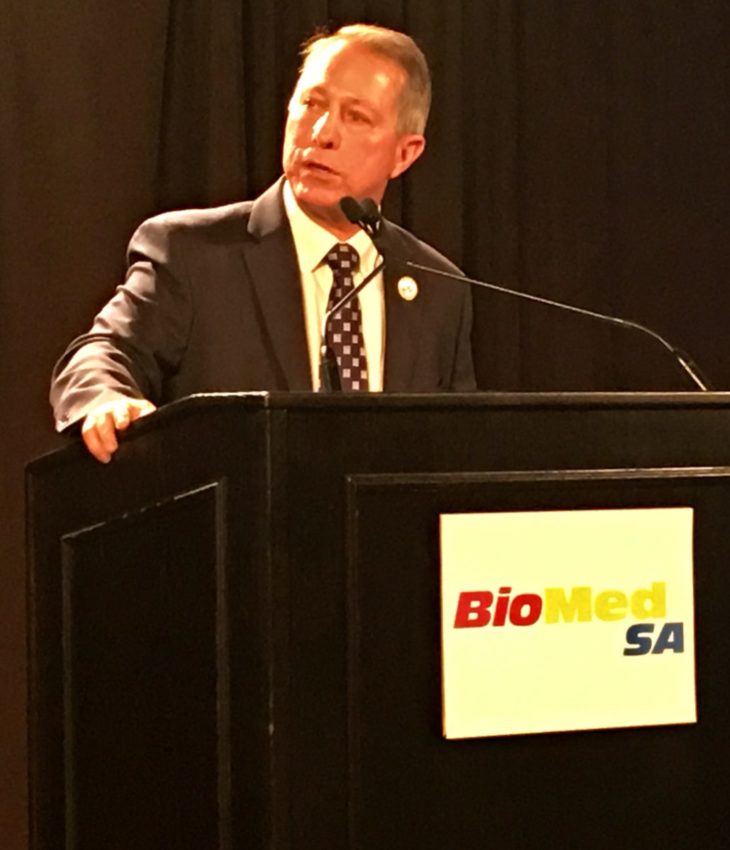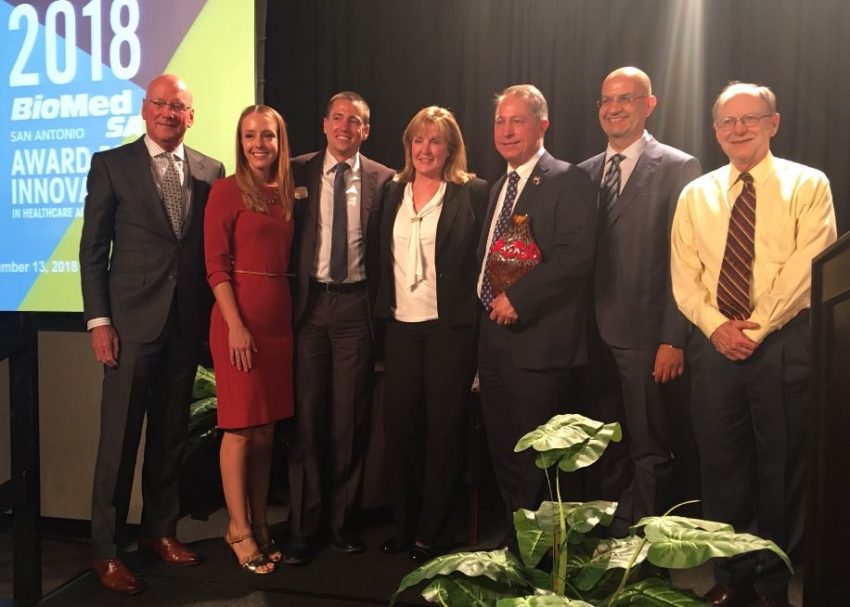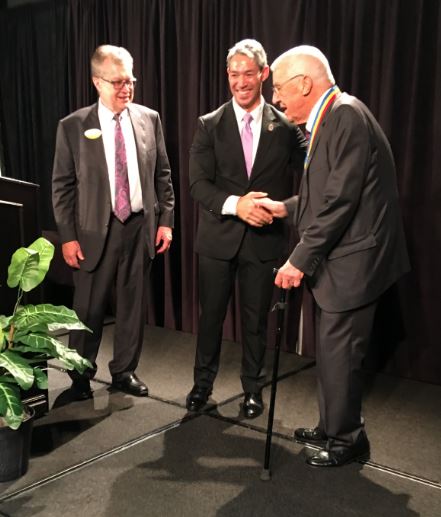Sept. 13 was a banner night for UT Health San Antonio faculty Alan L. Peterson, Ph.D., ABPP, and Basil A. Pruitt Jr., M.D., as BioMed SA presented them with its top awards for the year. In front of an audience of 500 at The Vista at Valero, Dr. Peterson received the 2018 Award for Innovation in Health Care and Bioscience, and Dr. Pruitt received the 2018 Lifetime Achievement Award. San Antonio Mayor Ron Nirenberg honored both men for their many contributions to military medicine.

- Alan Peterson, Ph.D., speaks at the Biomed SA gathering.
Dr. Peterson, professor of psychiatry, directs the South Texas Research Organizational Network Guiding Studies on Trauma and Resilience, or STRONG STAR. The U.S. Department of Defense and the U.S. Department of Veterans Affairs fund this multidisciplinary and multi-institutional research consortium. STRONG STAR’s goal is to develop and evaluate the most effective early interventions possible for detecting, preventing and treating combat-related posttraumatic stress disorder (PTSD) and related conditions in active-duty military personnel and recently discharged veterans.
During 21 years as a U.S. Air Force clinical psychologist, Dr. Peterson was among the first to recognize the need for evidence-based treatment of PTSD in active-duty service members. In 2004 he was part of a team that set up the first Air Force theater hospital in Balad, Iraq. “At times when we were there, it was the busiest trauma hospital in the world,” he said. “Balad was known as ‘Mortaritaville,’ because every day we seemed to have mortars and rockets coming down upon us. It was at the Air Force theater hospital that they started seeing the first posttraumatic stress cases in the war zone.”
Faced with the challenge of helping patients presenting with the disorder, Dr. Peterson looked in the medical literature for what would work in treating combat-related PTSD. “There was nothing,” he said. “There had not been a single clinical trial conducted on what to do for posttraumatic stress disorder.”
He looked for a secondary treatment and found information on prolonged exposure therapy, which had been developed and evaluated with female sexual assault survivors.
A convoy, a bomb and a boy
Dr. Peterson was especially impacted by the case of a 22-year-old airman who was doing convoy protection out of Balad. He was battle-hardened and doing well until one day, out on convoy, the lead vehicle was hit by a 500-pound car bomb. This airman was in about the fourth vehicle of the convoy, and provided combat lifesaver aid to brain-injured individuals of the lead vehicle. Then he was asked to provide security for a medic in the Iraqi center square.

“That was when he saw dozens of Iraqis who had been killed, many serious injuries were there, and coming around the corner, the one thing that bothered him the most was he saw this little kid who wasn’t more than about 10 years old, who had been hit by shrapnel,” Dr. Peterson said. “His face was severely injured, he had a compound fracture of his femur, and he was missing half of the foot on his other leg. The airman looked at the little boy and the child said, ‘American! American!’ And he talked to the little boy just like he would talk to any other little boy, and said, ‘I know what we need to do. I will get you to the hospital. We’re going to take care of you. I know what we need to do. I’ll be right back.”
The airman went back to the rest of the convoy and told them about the badly injured child, listing all the injuries. The convoy commander, however, was on the radio and gave orders to vacate the scene, to let the Iraqis take care of themselves. The airman vehemently protested, “No, we can’t do that. There’s this little kid, he can’t be more than 10 years old, we need to help him!” He was told no, and so he had to get on the back of his truck, and the last thing he saw as he rode off was this little Iraqi boy, sitting by a light post, waiting for someone to come and help him.
“I saw this airman 10 days later,” Dr. Peterson said. “Hundreds of times a day, he was seeing that little boy’s face. Every time he went to sleep, the video camera [in his mind] played and he relived the entire nightmare. He was very hyperaroused and avoiding [situations] [both symptoms of PTSD], but he didn’t want to go home.”
Dr. Peterson had not yet done prolonged exposure therapy for combat PTSD, but felt this was the treatment that would give the airman the best chance to remain in Balad and do well. Part of prolonged exposure, Dr. Peterson said, is to “basically ask the person to press play, in first person, present tense, with their eyes closed, to describe exactly what happened.”
A soldier restored
The first rendition of the airman’s remembrance was 76 minutes long. Dr. Peterson made an audio recording of it because the therapy includes listening to the tape of the memory. Dr. Peterson saw the airman three more times. Each time, as the airman processed the details and made sense of them, it got easier.
The airman started to remember lots of other details. “He remembered that an old man had been carrying the Iraqi boy and he thought, ‘I think somebody else who knew the boy was there, and I think he probably went to get help,’” Dr. Peterson said. “He then realized, ‘You know what? I think I know why the commander told us to leave. It was because of secondary explosions. That was the time when the terrorists began doing secondary explosions after people gathered around. You know what? I think I’m alive right now because my commander made that decision.’”
All of this happened in four sessions. At the end of the last one, the airman said to Dr. Peterson, “I think I’m good to go.” He went back on convoys, finished his deployment and volunteered to stay behind to help train replacements.
“I followed up with this young man eight years later,” Dr. Peterson told the audience. “He was still on active duty, he had been promoted four times, he had completed another deployment. He did not have posttraumatic stress disorder. It is an incredible story of resiliency in this one young individual, and it set the stage of me thinking of what I needed to do.”
Dr. Peterson came home from Iraq and after retiring from active duty in 2005 joined UT Health San Antonio. Today he serves as chief of the Division of Behavioral Medicine and leads STRONG STAR and another national consortium called CAP (the Consortium to Alleviate PTSD). He and his nationwide team of collaborators have attracted more than $150 million in funding and facilitated dozens of clinical trials aimed at improving care of individuals such as the young airman.
A father of burn medicine

Dr. Basil Pruitt, clinical professor of surgery, is one of the founding fathers of modern trauma and burn medicine. Dr. Pruitt was commander and director of the U.S. Army Institute for Surgical Research (USAISR) for 27 years before joining UT Health San Antonio in 1995.
He had previously served in Vietnam during the Tet Offensive of 1968, where he performed surgery at the 12th Evacuation Hospital, the busiest medical facility in the war.
Innovations he led at the USAISR resulted, over the last half-century, in a dramatic improvement in the survival of patients with severe burns. In 1959, a patient with burns over 43 percent of the body had a 50 percent chance of surviving. Today, the same patient’s survival chances have improved to more than 75 percent.
Dr. Pruitt has been a great educator of other surgeons. Forty-six surgeons he mentored became directors of burn centers and 11 became presidents of the American Burn Association.
The failed attempt to rescue the Iranian hostages in 1980 resulted in a helicopter crash that killed eight service members and injured five. Four were sent to the USAISR for treatment. “Each crisis was an opportunity for the USAISR team to demonstrate clinical excellence, which was driven by Dr. Pruitt,” said Col. Jerome L. Buller, M.D., USAISR commander, in a video tribute. “Dr. Pruitt was, and is, a dynamic, charismatic leader who fundamentally changed how the world cares for burn and trauma patients. He is a remarkable individual and very deserving of this Lifetime Achievement Award. I am honored to follow in his footsteps and to serve as commander of the USAISR, where I will continue the great work he started so long ago.”

